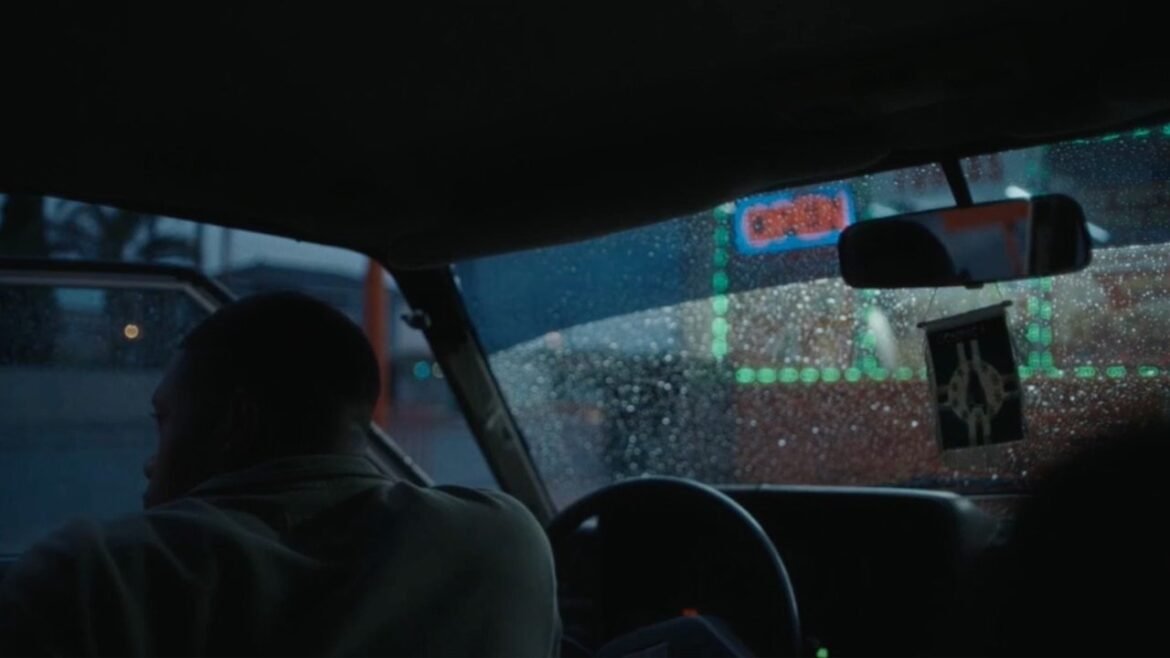Between Wes Anderson’s Roald Dahl adaptations on Netflix and the French New Wave shorts on DVD and on OVID.tv, I’ve had short films on the brain lately. But there’s one I’ve had in the forefront of my mind—and of my enthusiasm—since I saw it nearly a year ago: Dwayne LeBlanc’s “Civic.” I’ve seen it many times, starting when it was on YouTube and continuing to its current, richly deserved appearance on the Criterion Channel, and I’m unfailingly enthralled by its display of inventiveness, its dramatic scope, and its beauty—in other words, by its union of concept, substance, and style. It is LeBlanc’s first film—he wrote the story and co-wrote the script with Nicole Otero—and it gives a boldly modernist form to the classic tale of the prodigal’s return. A young man named Booker (Barrington Darius) shows up in his home neighborhood of South Central Los Angeles (where LeBlanc is also from) after an unspecified number of years away and attempts to reconnect with people he left behind.
The title is a play on words that conjures the film’s rich duality and its distinctive form, suggesting both the public sphere and an automobile. The film is shot entirely from within Booker’s car (not a Honda Civic, actually, but a 1981 Toyota); most of the action takes place inside it, and everything else is filmed through its windshield, windows, and open doors. Booker’s stated reason for returning is to see his mother, and his main encounters are with two longtime friends he’s fallen out of touch with: Tee (Maurice Powell), a gifted artist from high-school days who teases him about the old car and his new looks, and Harmonie (Courtney Gabrielle Williams), a nurse who’s on her way home. LeBlanc doesn’t go into detail about Booker’s activities, but it seems that he left home to fulfill his ambitions and vanished from his friends’ lives.
Booker’s encounters, fraught with memory and burdened by the years of silence, resound with the shock of their suddenness. The conversations, stressful enough as they are, gain a heightened intensity from the imposed proximity of the car’s front seat. They are roiled by questions unanswered, frustrations unresolved, dreams stifled, struggles endured. The cast’s performances, vigorous yet pensive, embody this poised complexity, and the movie suggests mighty currents of memory and emotion that emerge as much from its visual aesthetic as from its acting and script. The constraint of filming solely from inside the car presents a challenge that LeBlanc and his cinematographer, Andrew Yuyi Truong, meet by means of a tightly controlled but freely imaginative repertory of images, which cut into and out of Booker’s point of view. Sometimes tensely static and sometimes in roving motion, the shots play craftily with focus and with the car’s own architecture: like proscenium arches, the doors, windows, dashboard, and seats create frames within frames.
“Civic” is cinematic chamber music for voices. There are duets, trios, reflective and poignant solos, and even a jaunty quartet, all organized and harmonized by means of images and sounds that parse the dialogue and expand the encounters. The shots run long, long enough to savor the documentary essence of the automotive life—the pleasure of motion, the allure of city lights, the drama of possibilities, the lure of escape. The movie pays special attention to the vehicle’s sensory details: lights that go on and off, chimes that alert, latches that snap, windows that hum as they glide open and closed all serve to punctuate the talk and the action.
The movie, with its vivid evocation of Booker’s inner life, is intimate and personal, but LeBlanc also fulfills the wider social implications of its title. Without any explicit reference to political issues, “Civic” evokes—in hints, symbols, and overtones—the sense of a community under pressure, of residents in a tense and unsteady connection to the city at large. As Booker drives toward South Central, he faces, on freeways, a strange, overdeveloped, Alphaville-like city of futuristic interconnections and communication overload, but on arrival he encounters a neighborhood on the human scale—albeit a neighborhood under glass, scrutinized from the outside and surrounded by invisible barriers. A chance encounter with an engaging stranger (Starla Caldwell) occurs as a result of a breakdown of public transportation, a sign of more general failures of governance. The relationships that Booker rekindles all reflect the community’s tight bonds and common purpose, the inseparability of individual activity and collective well-being. This sense of rootedness in the virtual village piercingly sharpens the drama and places an onus of reconciliation on Booker: the gap left by his departure has been filled in by time and habit, and his return is a conspicuous curiosity, even a dubious intrusion.
The large-scale reverberance of LeBlanc’s film brings to mind the famous, and perhaps apocryphal remark by Martin Scorsese: “Cinema is a matter of what’s in the frame and what’s out.” I agree: a movie is much more than what’s onscreen; the entire world offscreen is an essential part of cinema. It’s the part that’s hardest for directors to encompass in their work because it comes not from the camera but from themselves. LeBlanc brings to bear on “Civic” his alert observations, serious reflections, and depth of feeling, making it reverberate far beyond the confines of one vehicle and far further than the limits of its mere nineteen minutes. ♦



